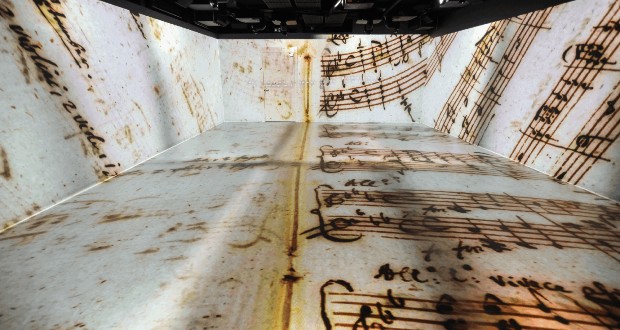Eleven Pixera media servers from AV Stumpfl play a major part at the exhibition in Vienna which also employs more than 300 QSC loudspeakers, 39 Epson projectors, and 18 Samsung screens.
When an artist’s work is still growing in relevance and influence hundreds of years after his death, that person has become a myth. With the new Mythos Mozart exhibition, situated in the heart of Vienna, visitors are introduced to the life and work of Wolfgang Amadeus Mozart in the form of an immersive experience.
The timeless beauty of the musical genius’s legacy meets the latest AV technology, with the 1,500 sq m exhibition itself – which is located at the precise location where the composer was born in 1756 and created masterpieces such as The Magic Flute – becoming a work of art in its own right.
Equipped with a ticket and a unique QR code, each visitor to Mythos Mozart has their photo taken at the start of their AV journey. Within two seconds, the photos are turned into digital 3D portraits that can wink back at them and jump from one picture frame to the next.
The exhibition comprises five rooms, each of which offers an access point to Mozart’s body of work and legacy. In the Vienna 1791 – Mozart’s City Room, visitors experience a tour through historical Vienna in the form of 360° projections that combine cityscapes with a balloon ride. In another room, interactive elements enable visitors to choose with which instrument they would like to accompany Mozart’s Eine Kleine Nachtmusik.
The Genius – Mozart Composing room allows visitors to enter Mozart’s creative mind in the form of thousands of synaptic connections framed by light and music. The exhibition’s final room, Magic Flute – Mozart Forever, the new-media artist Refik Anadol uses AI and millions of data points to create an evocative world of fantastical imagery.
To live up to the naturally high expectations regarding the music and sound quality, 300 ceiling and wall-mounted loudspeakers were installed, with additional speakers on the ground. Most of the speakers were provided by QSC, with the AC-S6T, AD-S8T, AD-S10T and AP-212SW models utilised.
QSC’s CX-Q8K8 and CX-Q4K8 power amplifiers support the setup and receive their signals via QLan from two QSC Core 510i audio processors. Mythos Mozart uses multiple main audio sources in the form of six Mac Minis with QLab software, controlled via the general AV setup in order to start the right audio tracks at the correct time. Two of the exhibition rooms feature active acoustics from Amadeus Acoustic.
To meet the special requirements of the exhibition rooms, 46 DPA microphones were used to make the room acoustics, for example, appear authentically church-like.
Pixera media server systems from Austrian AV technology manufacturer AV Stumpfl were employed as the main video playback system. Eight Pixera two and three Pixera one servers were installed to handle the large amount of video content and data.
Martin Nikendei, project manager at Austrian company PKE Electronics, which took on the role of technical service provider and installer, says: “We ask a lot of the servers, since our content updates can be rather large. My team likes the Pixera’s general interface philosophy very much. It is an intuitive and reliable system.”
PKE opted for four Epson EB-L635SU, 21 EB-PU1007B and 14 EB-PU2216B projectors. The company is the first in Europea to use EB-PU2216B laser projectors as part of an installation project.
Due to spatial limitations, ultra-short throw (UST) lenses were mainly used, in addition to some standard focal lengths. Six deflection mirrors turned the floor of one of the exhibition’s rooms into an additional projection surface.
Seven Samsung QM85R 85″, nine QM55R 55″ and single 43″ and 32” screens were used in the realisation of the exhibition. Edvision and ITD specified 23 open-frame monitors of varying sizes between 21” and 55” which are used for the ‘avatar wall’, along with three high-performance PCs.
The video transmission was implemented by using CYP HDBaseT-transmitters, which can each transmit 4K content. Twenty Leia LumePads were used for creating the interactive music station, with Ultraleap 3Di tracking cameras as part of the control solution. The general system control was created and programmed by PKE via a Linux computer.
Using more than 64TB worth of NAS storage capacity makes it possible to allow visitors to download their own content, such as Kleine Nachtmusik from the World Music room.
AV Stumpfl global marketing advisor Hans Christian Stucken says: “We hope that this wonderful exhibition will help people from all over the world to discover and explore the myth that is Mozart in manifold ways. Mozart in Vienna with cutting-edge technology made in Austria is a dream come true for us, as an Austrian manufacturer.”
Reference : AVinteractive


